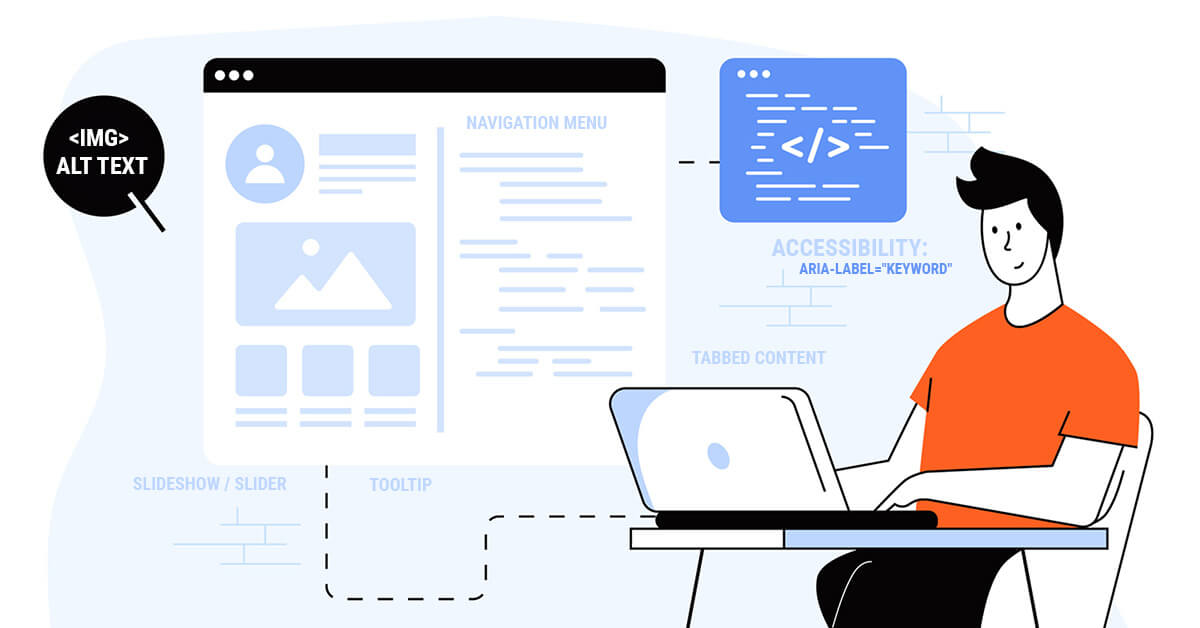Understanding Hidden Text & What Google Says About It
Google’s search engine algorithm has undergone major updates throughout the years. In the previous decade, many users attempted to manipulate the system using tactics like keyword stuffing and cloaking to achieve higher search rankings.

Incorporating hidden text is another technique for manipulating search results. This allows webmasters to insert extra keywords and phrases that only search engines can detect.
These deceptive techniques are known as black hat SEO, and Google will typically penalize websites caught using these methods, which can lead to lower search rankings and a significant drop in visibility.1
However, while hidden text has a somewhat controversial reputation, many digital marketers still practice it today for several reasons, including enhancing accessibility, optimizing page layout, and ensuring that search engines can accurately interpret the content without compromising user experience.
What is Hidden Text?
Hidden text is generally defined as the content on a webpage that isn’t seen by users but is accessible to search engines.

Typically, users sneak hidden text by using CSS tricks like setting the text colour to match the background, placing it inside a hidden div, and reducing the font size to zero. Google usually recognizes these manipulative techniques and responds by demoting the website’s rankings or even removing it from search results altogether.
When is Hidden Text Considered Deceptive?
According to Google’s latest guidelines about hidden text, it is deemed deceptive when it is implemented purely to manipulate search rankings and remains hidden from human visitors.2

Common violations include:
- Using white text on a white background
- Hiding text behind an image
- Using CSS to position text off-screen
- Setting the font size or opacity to zero
- Hiding a link by only linking one small character (for example, a hyphen in the middle of a paragraph)
These practices aim to deceive search engines by hiding content that is not meant for user interaction, and they violate Google’s policies.
When is it Acceptable to Use Hidden Text?
There are some instances where Google does not penalize hidden text.

Here are some cases when hidden text is considered acceptable:
- If the Intent is to Improve Accessibility: Hidden text can be used to make content accessible to screen readers for visually impaired users. For instance, using ARIA (Accessible Rich Internet Applications) attributes to provide additional context to screen readers.
- Navigation Menu: Interactive navigation menus, which expand when clicked, keep interfaces clean and streamlined, particularly on mobile devices. This reduces visual clutter and aids navigation, enhancing user experience without affecting search engine rankings.
- Image Alt Text: Alt text for images is usually hidden from sighted users but accessible to screen readers and search engines. It allows visually impaired users to understand images through screen readers, promoting inclusivity. For search engines, alt text provides context, aiding in indexing and boosting page relevance.
- Tabbed Content: Similar to navigation menus, its primary purpose is to organize information and make it easily accessible. Tabs allow users to switch between different content sections seamlessly, providing a more intuitive and structured way to access information without overwhelming the page.
- Slideshow or Slider: Slideshows or sliders cycle through several images or text paragraphs, presenting information dynamically without overwhelming the user. This keeps the page visually engaging and uncluttered, allowing for a better user experience.
- Tooltip or Interactive Text: Tooltips or similar elements display additional content when users interact with an element, such as hovering over or clicking on it. This technique provides context and supplementary information without cluttering the page, enhancing usability and user engagement.
As mentioned above, another acceptable way of incorporating hidden text is through hover text. This technique displays extra information when a user hovers over a particular element, similar to tooltips. Hover text differs in that it often provides more extensive details or context.
Is Hover Text Considered Unethical?
Although hover text does bear some resemblance to hidden text in that it is not always immediately visible, it is generally not considered deceptive.

According to Google’s Martin Splitt, using hover-over expandable text for navigational elements is generally acceptable, provided it enhances user experience and is not used to mislead search engines.3
Does CSS Hover Text Impact SEO? Should You Display Text All at Once Instead?
Using CSS or CSS3 to reveal text on hover is not inherently bad for SEO. In fact, it can significantly improve user engagement and accessibility, which are beneficial for your site’s SEO.

If used correctly, it can enhance your site’s user experience by providing additional context and information without cluttering the main page.
This method allows search engines to index the additional content, making your pages more informative and potentially improving your site’s relevance and ranking in search results.
On the other hand, designing your site to display text all at once can lead to a cluttered and overwhelming interface, which may detract from the user experience. Instead, using hover text selectively can maintain a clean design while still effectively delivering essential information.
Therefore, there is no need to redesign your website to display all text at once. Instead, use hover text strategically to maintain a clean design and enhance the user experience. Ensure that hover text adds value for users and is not overused to the point of seeming manipulative.
Final Takeaways
Hidden text and hover text can be invaluable tools to improve your site’s SEO when used correctly. These methods allow you to present supplementary information dynamically, enhancing user experience and accessibility. It’s important to implement them transparently and responsibly, ensuring that they add genuine value without attempting to manipulate search engine rankings.

At Wisevu, we thoroughly audit our clients’ pages and leverage techniques such as hover text to maximize their SEO potential. Our approach ensures that all enhancements are user-focused and SEO-compliant, helping to boost their online visibility and engagement and maintain their competitive edge in search rankings.
Sources:
- Hall, Sophia Bernazzani. “Black Hat SEO: 14 Techniques That Will Tank Your Site.” HubSpot, 13 June 2023, https://blog.hubspot.com/marketing/black-hat-seo.
- Google. “Spam Policies for Google Web Search.” Google Search Central Documentation, https://developers.google.com/search/docs/essentials/spam-policies?hl=en&visit_id=638563788432787242-997438211&rd=1#hidden-text-and-links.
- Schwartz, Barry. “Google: Expandable Hover Text Not Considered Cloaking.” Search Engine Roundtable, 10 Dec. 2021, https://www.seroundtable.com/google-expandable-hover-text-not-cloaking-31672.html
